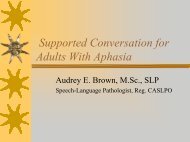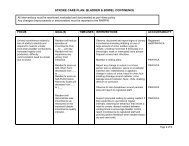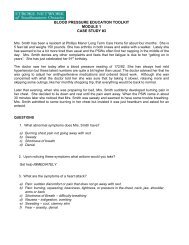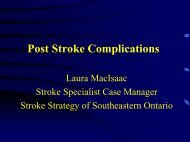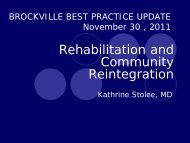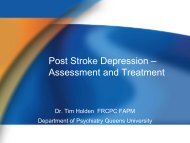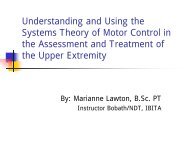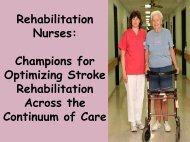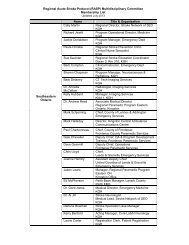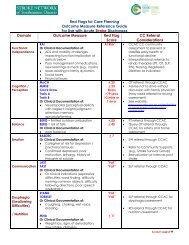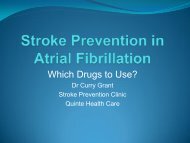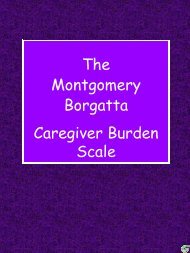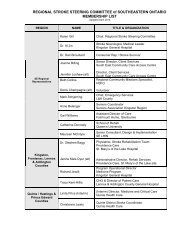Anatomy Sign Symptoms of Stroke - The Stroke Network of ...
Anatomy Sign Symptoms of Stroke - The Stroke Network of ...
Anatomy Sign Symptoms of Stroke - The Stroke Network of ...
Create successful ePaper yourself
Turn your PDF publications into a flip-book with our unique Google optimized e-Paper software.
<strong>Anatomy</strong>, <strong>Sign</strong>s and<strong>Symptoms</strong> <strong>of</strong> <strong>Stroke</strong>Pamela Bart,RN. MSc. . ACNPSoutheasternOntario RegionalAcute Care <strong>Stroke</strong>CNS/NP
Overview• Definition <strong>of</strong>stroke• Definition <strong>of</strong> TIA• Functioning <strong>of</strong> thebrain• Factors thatdetermine strokeseverity• Recovery fromstroke• Effects <strong>of</strong> <strong>Stroke</strong>• Recognizing signsand symptoms <strong>of</strong>stroke• Reacting to signsand symptoms <strong>of</strong>stroke• <strong>Stroke</strong> riskFactors (lifestyleand conditions)
<strong>The</strong> <strong>Anatomy</strong> <strong>of</strong> <strong>Stroke</strong>
<strong>Stroke</strong>• A sudden injury to a part <strong>of</strong> the braincaused by an interruption in its bloodsupply• Occurs when a blood vessel bringingoxygen and nutrients to a part <strong>of</strong> thebrain:• Becomes clogged (ischemic stroke) or• Bursts (hemorrhagic stroke)T & T page 5 & 6
Blood Vessel Becomes Clogged(Ischemic <strong>Stroke</strong>)
Ischemic <strong>Stroke</strong>
Ischemic <strong>Stroke</strong>
Blood VesselBursts(Hemorrhagic<strong>Stroke</strong>)
Hemorrhagic <strong>Stroke</strong>
TIA (Transient Ischemic Attack)• A mini-stroke caused by a temporarilyblocked blood vessel• <strong>Symptoms</strong> usually last only a few minutes• Can be an important warning sign that aperson may have a stroke in the future• TIA comes before a stroke in some cases• TIAs should never be ignored
<strong>The</strong> brain functions…Like a computer centre, controlling our:• Personality• Emotions• Behaviour• Movement and coordination• Sensation (touch, temperature, pain andperception <strong>of</strong> movement/position)• Vision• Perception (ability to accurately interpret whatwe see)• Memory, problem-solving and reasoning• Communication (speaking and understanding) andSwallowing• T & T page 9
• 2 HemispheresBrain <strong>Anatomy</strong>• Cerebral Cortex (moving, feeling,thinking, speech, vision, complextasks)• Sub-cortical structures (manyfunctions outside <strong>of</strong> consciouscontrol)• Brain stem and cerebellum (controlsvital functions and coordination)
SOMATOSENSORYHOMONCULUS
Factors that Determinethe Effect <strong>of</strong> a <strong>Stroke</strong>• Location <strong>of</strong> damage• Severity <strong>of</strong> damage• How well the body repairs the bloodsupply to the brain• How quickly other areas <strong>of</strong> brain tissuetake over the work <strong>of</strong> the damaged cells
Recoveringafter a<strong>Stroke</strong>
Recovery• <strong>The</strong> most rapidrecovery occursduring the first 3 to4 months• Recovery maycontinue over manymonths or years
RecoveryRecovery process is affected by the:• Survivor's age and general health• Survivor's personality• Survivor's coping abilities andemotional state• Support <strong>of</strong> family and loved ones
Effects <strong>of</strong> <strong>Stroke</strong>• Effects can be long- lasting andvary widely• Approximately 50% <strong>of</strong> the peoplewho have a stroke will have somedegree <strong>of</strong> long-term disability
<strong>Sign</strong>s and <strong>Symptoms</strong>Recognize & React
Recognize <strong>Sign</strong>s and <strong>Symptoms</strong> <strong>of</strong> <strong>Stroke</strong>SUDDEN• weakness, numbness and/or tingling in theface, arm or leg(usually one sided).• loss <strong>of</strong> speech or trouble understandingspeech• loss <strong>of</strong> vision, particularly in one eye, ordouble vision• severe and unusual headache, or change inthe pattern <strong>of</strong> headaches• loss <strong>of</strong> balance, dizziness, unsteadiness orsudden falls, especially with any <strong>of</strong> the abovesigns.
SCENARIOS<strong>Sign</strong>s and<strong>Symptoms</strong> <strong>of</strong><strong>Stroke</strong>
Left Hemisphere <strong>Stroke</strong>Refer to T & T page 9View video clipIdentify effects <strong>of</strong> stroke• Movement• Sensation• Understanding andExpressing speech• Vision
Right Hemisphere <strong>Stroke</strong>Refer to T & T page 9View video clipIdentify effects <strong>of</strong> stroke:• Movement• Sensation• Speech• Vision loss• Awareness <strong>of</strong> Left side
Posterior brain (brain stem)strokeRefer to T & T page 9View video clipIdentify effects <strong>of</strong> stroke:• Movement• Balance/coordination• Speech• Vision• Other symptoms
REACT to <strong>Sign</strong>s and <strong>Symptoms</strong><strong>of</strong> <strong>Stroke</strong>• Recognize symptoms• Record time <strong>of</strong> onset or time lastseen well• Community stroke: dial 911
REACT to <strong>Sign</strong>s and <strong>Symptoms</strong> <strong>of</strong> <strong>Stroke</strong>• LTC facility: Followinstitutions policy:• Inform RN/RPN in charge• Action taken will dependon client’s advanceddirectives, or directionsfrom power <strong>of</strong> attorneyfor personal care
<strong>Stroke</strong> Risk• <strong>The</strong> risk <strong>of</strong> stroke for individualswith TIA is 5% in 48 hours , 8%within 1 month and 12% within 1year• Approximately 25% <strong>of</strong> <strong>Stroke</strong>Survivors experience a recurrentstroke within 5 years
<strong>Stroke</strong> Risk Factors• Cigarettesmoking• SedentaryLifestyle• Alcohol abuse• Unhealthy diet• ObesityLifestyle
<strong>Stroke</strong> Risk Factors: Conditions• High Blood Pressure• Diabetes• High Cholesterol• Heart and/or valve disease• Heart Failure• Atrial Fibrillation• Carotid Artery Stenosis• Family History• Coagulation Disorders• Psychological Factors
Why do I need to knowsigns and symptoms <strong>of</strong>stroke?
Increase myunderstanding<strong>of</strong> problemsexperiencedby residentswho have had astroke
Enable me totake actionsto helpresidentswho havehad a stroke
Help me to improvecare for residentswho have had a stroke



